Not enough time for...
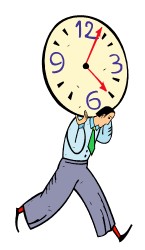 Not enough time for teaching... to cover the syllabus/curriculum...
Not enough time for teaching... to cover the syllabus/curriculum...
Not enough time to pick up new skills... to try new things...
Not enough time to reach each student... to personalise learning...
Not enough time to have professional conversations... to co-construct...How can we use time differently?I've been thinking about how my own use of time has changed over the last few years - both in and out of class...
In class I now...
- offer online learning and printed resources instead of writing notes on a board
- use student self/peer assessment to complement my assessment
- spend less time assessing and when I do it's usually sitting down in conversation with each student
- spend more time listening to student presentations
- spend more time online - viewing student work, commenting on blogs and in other student spaces, setting new tasks, researching links for just-in-time teaching...
- expect students to ask more questions rather than just provide "answers" to my questions
- spend more time showing a few students something and then asking them to show others
- expect students to ask each other (or seek online help) before asking me
- learn something new from students instead of always teaching/facilitating
Out of class I now...
- dictate text rather than using a keyboard (and more recently produce podcasts, screencasts, videocasts rather than written documents for class or other teachers)
- use electronic calendars with meeting functionality
- use IM instead of email to make casual contact with students and colleagues
- walk into other classes and chat with teachers/students
- do much less preparation for class and much less assessment
At home I now...
- read work emails in morning before going to work - (take time off in lieu when appropriate)
- read blogs instead of morning newspaper - (a much more uplifting experience)
- participate in online events - conferences, seminars, courses, meetings, blogging - (take time off in lieu when appropriate)
- work from home with high speed internet access to school resources - (take time off in lieu when appropriate)
So the way I use time has changed... even more than I'd realised...
Was it easy to change? No! There was a transition period where I was trying to do what I had always done while trying new things - spending too many hours at work and home - not healthy :-)
But I soon discovered that students
- do just as well if I don't assess everything
- learn just as much if I don't write everything on the board
- take more responsibility for their own learning if I don't always provide the "answer"
- learn just as much from each other as me
- can still cover the course if they take time to research and present to the class themselves
Plus I have found that I can do some work tasks much more efficiently from home.
Many of my colleagues however still spend a great deal of their time preparing and assessing work while trying to read emails and adapt to new curriculum. For many Wednesday feels like Friday. It's not sustainable.
For these teachers self/peer assessment is not believed to be realistic. Taking time to do anything other than "cover the curriculum" is believed to be time-wasting. Learning new skills in IT is seen to be impossible given the lack of time...
Graphic from MS Clipart: Non-commercial useLabels: teaching
Special Interest Groups
Next year we are planning to offer students the option of joining Special Interest Groups (SIGs) that are tied to our normal mentor/counselling groups.
In the past all students were timetabled to attend a mentor/counselling group for 30 mins once a week with a teacher. This year one of these groups was set up around a student area of interest so that rather than students having a common teacher or subject they have a common interest. It has worked very well with much better attendance and enthusiastic participation.
Several groups of teachers have now decided to offer a range of such Special Interest Groups for 2007. The idea is that two or more teachers will combine their mentor/counselling groups to form a larger group that is facilitiated by a team of teachers. Students are curently nominating a SIG on their 2007 enrolment forms.
Student interest has been very high. The details have yet to be worked out but in essence the groups will have one timetabled meeting each week with other activities organised by teachers, students or memebers of the wider community.
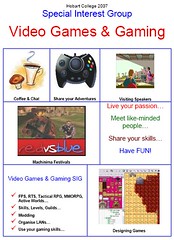 | 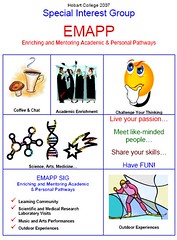 |
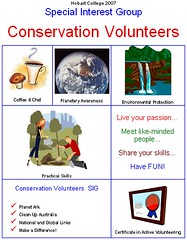 | 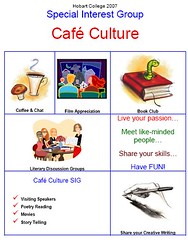 |
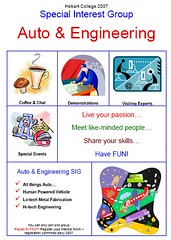 | 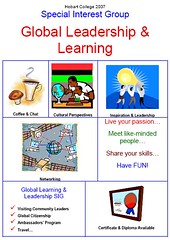 |
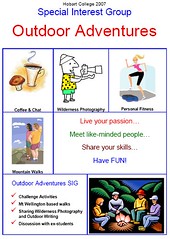 | Students will be offered coffee and raison toast (a big hit with this year's group) and special events in and out of school.
We still have many details to work out but the notion of a group of heterogeneous students meeting and chatting about an area they are passionate about has a lot of appeal...
Today I read about the Virtual Learning Commons at the University of Manitoba via George Sieman's blog. This is a great idea and I'm wondering if we can extend the special interest concept to self-organising student groups as well - even if they are just virtual.
|
Should we get our students to use
43 Things and add a tag for our school so that students can find each other or should we (could we) do something like the U of M?
Labels: engagement, learning, personalisation
Transformational Leadership Frameworks
Five Conceptual Frameworks for transformational leadership focussing on "generating the breakthrough insights needed to generate new commitments, behaviour, and results for individuals, institutions and societies."
I've just read Monica Sharma's article in the latest issue (No.12) of
shift from
IONS. She describes an
integrated "transformative leadership" methodology she helped develop for the
United Nations Development Program in 2001. Her
Transformative Leadership Development Program (2005) has now reached 4.5 million people across 40 countries with a particular focus on creating leadership capacity to help countries respond to HIV/AIDS.
According to a report on the
UNDP European website the Five Conceptual Frameworks provide easily transferrable tools for transformation that have been effective at all levels of society and across diverse cultures.
What would happen if we used these tools for educational change? And also for empowering students as we promote global citizenship?
Sharma's
five frameworks for transformative leadership (
Annexes 3) are:
- Leadership Competencies and Distinctions
- Emotional Intelligence Framework - based on the work of Daniel Goleman
- Four-Quadrant Framework - based on the work of Ken Wilber
- Levels of Organisational Development - based on the work of Rensis Likert
- Dynamic Strategic Planning Processes - based on appreciative inquiry
These frameworks are used within a systems thinking approach based on the work of Peter Senge.
According to Sharma the frameworks provide conceptual maps that "suggest ways of perceiving, understanding, and interpreting the world that may be different from our usual conditioning."
She says the Transformative Leadership Development Program (TLDP)
"emphasizes that the level of learning necessary to develop transformational leaders goes beyond sharing theories, learning new techniques, or gathering information. It is a process that actually works at a level deep enough to discover and shift who people are being, not what they know; it is for individuals who are ready and willing to be learners and to engage in a process of profound personal growth."
Sounds like something we need in our education systems... :-)
I like the way the TLDP not only uses coherent conceptual frameworks as a kind of holistic lens that highlights multiple aspects of an issue, but also the way several frameworks are integrated to provide a multidimensional picture of a system... hopefully giving a better chance for sustainable systemic change.
Which frameworks/tools would best facilitate educational transformation? Would the same set also be appropriate for students involved in leadership?
Perhaps Gardner's Multiple Intelligences Framework could be added to Goleman's Emotional Intelligence Framework? Perhaps Grave's Spiral Dynamics could be added to Likert's framework? Perhaps Senge's U-Process could be added to the strategic planning processes?
There is certainly no shortage of tools! Do we know how to use them? Can we afford not to use them?
Sources:
Sharma, M (2006) Conscious Leadership at the Crossroads of Change in shift (No.12): IONS
UNDP Report Annexes 3 - Accessed from UNDP European website on 17th Sept. 2006
Labels: conceptual frameworks, leadership, transformation











